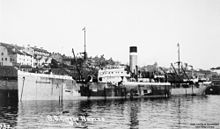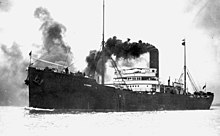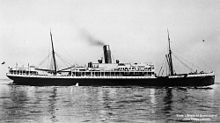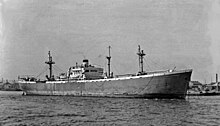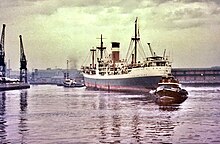
The Cunard Line is a British shipping and cruise line based at Carnival House at Southampton, England, operated by Carnival UK and owned by Carnival Corporation & plc. Since 2011, Cunard and its four ships have been registered in Hamilton, Bermuda.

An ocean liner is a type of passenger ship primarily used for transportation across seas or oceans. Ocean liners may also carry cargo or mail, and may sometimes be used for other purposes. The Queen Mary 2 is the only ocean liner still in service to this day.
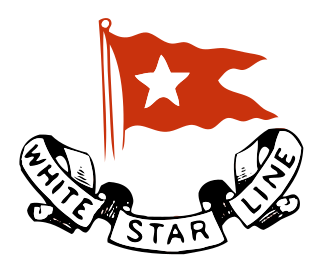
The White Star Line was a British shipping line. Founded out of the remains of a defunct packet company, it gradually rose up to become one of the most prominent shipping companies in the world, providing passenger and cargo services between the British Empire and the United States. While many other shipping lines focused primarily on speed, White Star branded their services by focusing more on providing comfortable passages for both upper class travellers and immigrants.

The Blue Star Line was a British passenger and cargo shipping company formed in 1911, being in operation until 1998.

The International Mercantile Marine Company, originally the International Navigation Company, was a trust formed in the early twentieth century as an attempt by J.P. Morgan to monopolize the shipping trade.

CP Ships was a large Canadian shipping company established in the 19th century. From the late 1880s until after World War II, the company was Canada's largest operator of Atlantic and Pacific steamships. Many immigrants travelled on CP ships from Europe to Canada. In 1914 the sinking of the Canadian Pacific steamship RMS Empress of Ireland just before World War I became largest maritime disaster in Canadian history. The company provided Canadian Merchant Navy vessels in World Wars I and II. Twelve vessels were lost due to enemy action in World War II, including the RMS Empress of Britain, which was the largest ship ever sunk by a German U-boat.

American Export-Isbrandtsen Lines, New York, was the leading US-flag shipping company between the U.S. east coast and the Mediterranean from 1919 to 1977, offering both cargo ship and passenger ship services, until it declared bankruptcy and was acquired by Farrell Lines of New York.

Hamburg Südamerikanische Dampfschifffahrts-Gesellschaft A/S & Co KG, widely known as Hamburg Süd, is a German container shipping company. Founded in 1871, Hamburg Süd was among the market leaders in the North–South trade. It also served all significant East–West trade lanes.
The International Navigation Company (INC) was a Philadelphia-based holding company owning 26 ships totaling 181,000 tons and carried more passengers than either Cunard or White Star, when the company was reorganized as International Mercantile Marine in 1902. The General Assembly of the Commonwealth of Pennsylvania approved a charter for the INC on May 5, 1871. The company was commonly known as the Red Star Line due to the red star on its white house flag. The principal American organizer and general agent of INC was the shipbroking firm of Peter Wright & Sons, one of the oldest, most respected, and most financially prosperous of the Philadelphia import-export houses. Principal financial backing was provided by the Pennsylvania Railroad Company. Although the financial interests were headquartered in the United States, the backers did not believe that a transatlantic steamship line could be run successfully under an American flag. Ships were to be built in foreign yards, operated under foreign flags, and manned with foreign crews.

Overseas Containers Limited (OCL) was a container shipping company formed by a consortium of British shipping companies in 1965. It was taken over by P&O in 1986.

Furness Withy was a major British transport business. It was listed on the London Stock Exchange.

Elder Dempster Lines was a UK shipping company that traded from 1932 to 2000, but had its origins in the mid-19th century.

Alfred Booth and Company was a British trading and shipping company, founded in 1866 and traded for more than a century. It was founded in Liverpool, England, by two brothers, Alfred and Charles Booth to export English light leather to the US. It grew into a significant merchant shipping company with its head office in Liverpool and interests in the United States and South America. The group was broken up in 1964 and the last Booth company from the group was sold in 1986.

HMS Baralong was a cargo steamship that was built in England in 1901, served in the Royal Navy as a Q-ship in the First World War, was sold into Japanese civilian service in 1922 and scrapped in 1933. She was renamed HMS Wyandra in 1915, Manica in 1916, Kyokuto Maru in 1922 and Shinsei Maru No. 1 in 1925.

The Moore-McCormack Lines was a series of companies operating as shipping lines, operated by the Moore-McCormack Company, Incorporated, later Moore-McCormack Lines, Incorporated, and simply Mooremack, founded in 1913 in New York City. It ceased trading on its buy-out in 1982. The founders were Albert V. Moore (1880–1953) (director/president) and Emmet J. McCormack (director/treasurer), with Mr Molloy (director/secretary).

The New Zealand Shipping Company (NZSC) was a shipping company whose ships ran passenger and cargo services between Great Britain and New Zealand between 1873 and 1973.

Harrison Line, officially T&J Harrison, was a shipping line founded by the brothers Thomas and James Harrison in Liverpool, England in 1853. It ran both cargo and passenger services, starting with the import of French brandy from Charente.

The Leyland Line was a British shipping transport line founded in 1873 by Frederick Richards Leyland after his apprenticeship in the firm of John Bibby, Sons & Co. After Frederick Leyland's death, the company was taken over by Sir John Ellerman in 1892. In 1902, the company was bought by the International Mercantile Marine Company and a portion of its fleet was withdrawn from service and transferred to the Ellerman Lines. The company was liquidated in 1935 after a period of declining influence due to the Great Depression.

Port Line was a passenger and cargo shipping company, initially formed as the Commonwealth and Dominion Line in 1914, and in operation in one form or another until 1982.

Lamport and Holt was a UK merchant shipping line. It was founded as a partnership in 1845, reconstituted as a limited company in 1911 and ceased trading in 1991.


